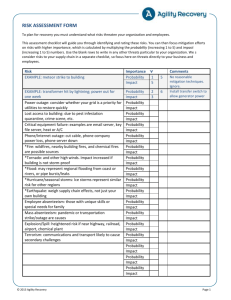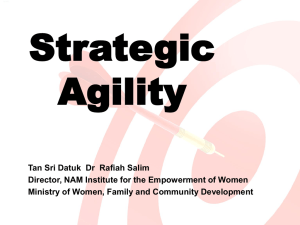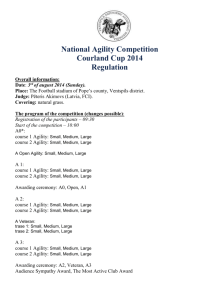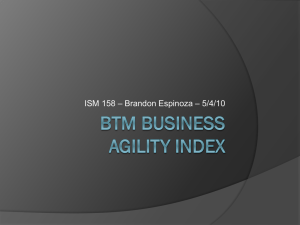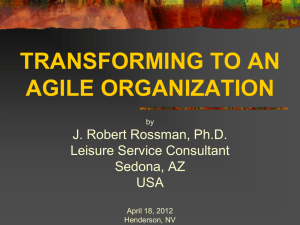Business Process Modeling and Agility
advertisement
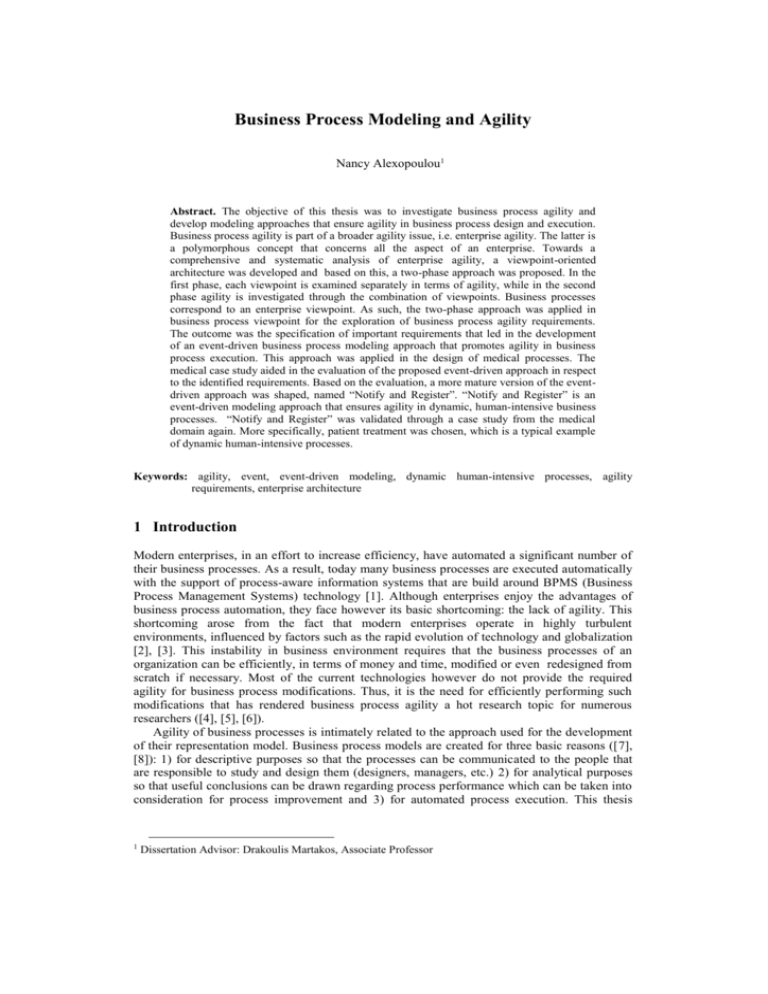
Business Process Modeling and Agility Nancy Alexopoulou1 Abstract. The objective of this thesis was to investigate business process agility and develop modeling approaches that ensure agility in business process design and execution. Business process agility is part of a broader agility issue, i.e. enterprise agility. The latter is a polymorphous concept that concerns all the aspect of an enterprise. Towards a comprehensive and systematic analysis of enterprise agility, a viewpoint-oriented architecture was developed and based on this, a two-phase approach was proposed. In the first phase, each viewpoint is examined separately in terms of agility, while in the second phase agility is investigated through the combination of viewpoints. Business processes correspond to an enterprise viewpoint. As such, the two-phase approach was applied in business process viewpoint for the exploration of business process agility requirements. The outcome was the specification of important requirements that led in the development of an event-driven business process modeling approach that promotes agility in business process execution. This approach was applied in the design of medical processes. The medical case study aided in the evaluation of the proposed event-driven approach in respect to the identified requirements. Based on the evaluation, a more mature version of the eventdriven approach was shaped, named “Notify and Register”. “Notify and Register” is an event-driven modeling approach that ensures agility in dynamic, human-intensive business processes. “Notify and Register” was validated through a case study from the medical domain again. More specifically, patient treatment was chosen, which is a typical example of dynamic human-intensive processes. Keywords: agility, event, event-driven modeling, dynamic human-intensive processes, agility requirements, enterprise architecture 1 Introduction Modern enterprises, in an effort to increase efficiency, have automated a significant number of their business processes. As a result, today many business processes are executed automatically with the support of process-aware information systems that are build around BPMS (Business Process Management Systems) technology [1]. Although enterprises enjoy the advantages of business process automation, they face however its basic shortcoming: the lack of agility. This shortcoming arose from the fact that modern enterprises operate in highly turbulent environments, influenced by factors such as the rapid evolution of technology and globalization [2], [3]. This instability in business environment requires that the business processes of an organization can be efficiently, in terms of money and time, modified or even redesigned from scratch if necessary. Most of the current technologies however do not provide the required agility for business process modifications. Thus, it is the need for efficiently performing such modifications that has rendered business process agility a hot research topic for numerous researchers ([4], [5], [6]). Agility of business processes is intimately related to the approach used for the development of their representation model. Business process models are created for three basic reasons ([7], [8]): 1) for descriptive purposes so that the processes can be communicated to the people that are responsible to study and design them (designers, managers, etc.) 2) for analytical purposes so that useful conclusions can be drawn regarding process performance which can be taken into consideration for process improvement and 3) for automated process execution. This thesis 1 Dissertation Advisor: Drakoulis Martakos, Associate Professor focuses on the third case, which means that the research conducted in the context of this thesis concerns executable models. Model development constitutes a current trend as also revealed by other fields such as software development [9] and information systems design [10]. The reason is that models can play effectively the role of the interface between humans and machines, ensuring on one hand an easy-to-understand representation for humans and, on the other, providing a formalism, which, through the appropriate rules, can be automatically transformed into a machine-readable language. It follows that the agility characterizing a business process is reflected onto the process model. Therefore, the adoption of a business process modeling approach which produces agile models is critical. The exploration of business process agility, with ultimate target the development of a business process modeling approach that ensures agility in the design and execution of business processes, constitutes the subject of the present thesis. While business process agility concerns a plethora of researchers, there is no however in the literature a systematic way for its thorough analysis. Therefore, to systematically explore business process agility, an initial target of this thesis was the development of a broader framework that the concept of business process agility falls into. As deduced from the literature, business process agility is a constituent of enterprise agility, which denotes the ability of an enterprise to efficiently respond to new conditions. To analyze enterprise agility, a viewpoint-oriented enterprise architecture was developed. Based on this architecture, a two-phase approach was proposed for a holistic analysis of enterprise agility. The viewpoint-oriented enterprise architecture and the two-phase approach are presented in section 2. The way this approach was applied for the investigation of business process agility and the requirements that were identified regarding the attainment of business process agility are briefly discussed in section 3. Based on these requirements, an event-driven modeling approach was developed aiming at the creation of agile business process models. The first version of this approach is discussed in section 4, while in section 5 the more mature version of this approach, called “Notify and Register”, is presented. Conclusions lie in section 6. 2 A Structured Approach for the Exploration of Enterprise Agility To explore the concept of enterprise agility taking into consideration all necessary aspects, an approach was proposed that is based on a viewpoint-oriented Enterprise Architecture, which treats all organizational perspectives as of equal importance [11]. According to Schekkerman [12] “Enterprise architecture is about understanding all of the different elements that go to make up the enterprise and how these elements interrelate”. IEEE‟s Recommendation Practice for Architectural Description of Software-Intensive Systems [13] proposes that an architecture is a collection of viewpoints, i.e. architectural descriptions that concern each individual stakeholder. Each viewpoint is associated with a specific view. A view is a representation of a whole system from the perspective of a related set of concerns. This approach has been adopted by various initiatives ([10], [14]). In a similar manner, the central principles that define the IEEE recommendation can be applied in order to specify a viewpoint-oriented Enterprise Architecture. Such an architecture may portray in an holistic manner all aspects of an organization that should be considered in respect to agility. Various classifications of organizational domains described through an Enterprise Architecture can be found in the literature ([12], [15], [16]). Arguably, the key design elements can be depicted through the following five viewpoints: Human Resources, Operational, Administrative, Data Assets and Information Technology (Figure 1). These viewpoints are the structural constituents of an enterprise and collectively they support strategy and mission related to the behavioural hypostasis of the enterprise; hence strategy and mission are not considered as discrete viewpoints in the proposed Enterprise Architecture which is focused on the structural organizational aspects. Human resources viewpoint focuses on aspects related to knowledge, competences and skills exhibited by people working in an enterprise, plus the culture they have. People play an important role in contributing towards the achievement of enterprise agility. They are „stakeholders‟ in the sense that they have a stake in the organization whose welfare affect and which in turn affects them. The „agile stakeholder‟ is a new breed of sophisticated user or employee that is needed – someone who is technologically competent and with a culture that is alien to the “I have always done it this way!” mentality. The agile stakeholders operate within the limits defined by the organizational structure of an enterprise, addressed by the Administrative viewpoint. An enterprise, in order to be deemed agile, should be always willing to adjust its organizational structure, if environmental demands prove its function inefficient. Agility of organizational structure though, is often hindered due to conflicts arising from the established relationships in the existing hierarchy. It should be realized however that the way an enterprise is organised, affects the efficiency of decision making, as well as of activity coordination and execution which directly determine the overall agility exhibited by the enterprise. Data Assets viewpoint focuses on the management of organizational data which constitute the most valuable asset of a modern enterprise. Effective data management may ensure high quality of information as well as its efficient diffusion among the stakeholders. Information is mainly critical for sensing agility [17] as it is intimately related to knowledge acquired through its effective exploitation. Operational viewpoint concentrates on the organization and management of business processes. The ability to respond rapidly to changing marketing opportunities by utilizing agile business processes is considered a key attribute of an agile enterprise [18]. Information Technology (IT) viewpoint concentrates on the underlying IT infrastructure as well as the provided software applications. As nowadays enterprise operation is extensively based on IT, IT agility is a critical factor for the success of corporation during periods of intense change, especially if agility in IT infrastructure acts as a foundation for overall IT flexibility [19]. Administrative Viewpoint Human Resources Viewpoint Data Assets Viewpoint Operational Viewpoint Information Technology Viewpoint Figure 1. A viewpoint-oriented Enterprise Architecture The identification of different viewpoints facilitates the procedure of agility analysis, as it is easier through the „separation of concerns‟ to focus on certain issues associated with a specific viewpoint. However, as these viewpoints are interrelated, analyzing enterprise agility by merely considering each viewpoint in isolation does not suffice. What is additionally required is the examination of view interrelations, resulting in the „integration of concerns‟. As such, the proposed approach for analyzing enterprise agility includes two phases: - separation of concerns: enterprise agility is examined from each different viewpoint. - integration of concerns: enterprise agility is examined through the interrelation between the corresponding views. Numerous researchers have attempted to analyze agility and identify desirable or necessary properties. However, although these previous attempts provide valuable insights, they fell short of projecting a comprehensive framework to guide systematically the interested party through a path that will lead to an understanding of this polymorphous and complex concept. To this end, based on the suggested viewpoint-oriented Enterprise Architecture, a structured way is provided for the identification of agility issues which may be followed by the extrapolation of corresponding agility requirements. The two phase approach enables the systematic discovery of issues [11] so that the latter are not missed and consequently ignored in the development of a comprehensive solution for the attainment of enterprise agility. 3 Applying the Two-Phase Approach for the Investigation of Business Process Agility Requirements From the issues that can be derived through the two-phase approach [11], this thesis focuses on those corresponding to the Operational Viewpoint (separation of concerns), which refers to the business processes of the enterprise, since business process agility is the subject of the research conducted in this thesis. However, as this thesis focuses on executable models, the integration of concerns, regarding Operational and Information Technology viewpoints was also examined. As such the issues explored are α) is there a modeling approach that can ensure the efficient adjustment of a business process model (separation of concerns) and b) how can IT infrastructure effectively support modifications in running business process instances (integration of concerns)? Business Process 1st requirement: the modeling approach should be in harmonization with the nature of the business process to be modeled Metamodel Separation of concerns: Business Process view ? Integration of concerns: Business Process view and IT view Metamodel 2nd requirement: the modeling approach should support the development of modular models, so that agility during execution can be ensured IT-oriented view of business processes transformation of each activity separately business processoriented view of ΙΤ BPM Engine Interpreter-like execution Figure 2. The integrated picture regarding business process agility requirements The exploration of these issues through the two-phase approach unearthed two basic requirements for the attainment of business process agility: a) the modeling approach should be in harmonization with the nature of the business process to be modeled b) the modeling approach should support the development of modular models, so that agility during execution can be ensured. After the identification of these two requirements, the next step in the present thesis was to investigate whether it is possible to develop a modeling approach that can describe a business process in a modular way, so that modifications during run time can be facilitated and at the same time ensure the harmonization with the business process nature, satisfying thus both requirements (Figure 2). In an effort to find such a modeling approach, the characteristics of the existing modeling paradigms were explored. The objective of this exploration was to shape a thorough and clear picture regarding these paradigms, which would facilitate the selection of the appropriate paradigm for the development of the modeling approach in research. The basic modeling paradigms and the characteristics that ensued are summarized in Table 1. Table 1. Modeling paradigms and their features Modeling Paradigms Features Action-driven emphasis is laid on how the target of modeling is the process flow modeling begins with the identification of actions mainly suitable for well-structured processes Data-driven emphasis is laid on what the target of modeling is data management modeling begins with the identification of data entities mainly suitable for processes of vague structure Event-driven emphasis is laid on when the target of modeling is event handling modeling begins with the identification of meaningful events mainly suitable for processes that are affected by unpredicted contingencies Role-driven emphasis is laid on who focus is on interaction between roles modeling begins with the identification of roles mainly suitable for communication-based processes In order to develop modular models, the modeling approach should not aim at creating an integral sequence of activities. Alternatively, it could depict each activity that takes place in the organizational environment in an autonomous manner. The latter would require also the description of the conditions that would lead to the initiation of each activity. According to the examination of the modeling paradigms that took place in the present thesis, the appropriate paradigm for the description of the conditions that initiate an activity is the event-driven one. Through the use of events, independent and autonomous activity modeling can be facilitated. Each activity can be considered to be invoked by specific events and also it can be assumed that the accomplishment of each activity may cause new events. The interdependencies among activities may be expressed through event correlations. As a result, the sequence of activities may evolve dynamically during execution time based on the event occurrences, without having a specific activity sequence predefined at the design phase. A set of autonomous activities may be specified instead, during the design phase, facilitating thus modularity. Therefore, in order to satisfy the identified requirements for the attainment of business process agility, an event-driven modeling approach was proposed in this thesis. 4 Discussing the Developed Event-Driven Modeling Approach The proposed event-driven modeling approach ([20], [21]) used the concept of event in order to support the development of modular models. The first version of the proposed event-driven modeling approach was applied in two medical processes, patient admission and patient treatment, under a case study that was conducted in a Greek hospital. The case study aided in the evaluation of the proposed modeling approach. The evaluation revealed that though the proposed approach facilitates the modifications of business process instances during execution time thanks to the modular models created (the second business process agility requirement), it is characterized however by high complexity in the design and readjustment of the model hindering thus agility to a significant extent. This shortcoming stemmed from the fact that the identified requirement dictating the harmonization of the modeling approach with the nature of the process being modeled was not adequately focused. As a result, adopting the event-driven paradigm for the description of patient admission, which is a well structured process and thus could naturally be described through a sequence of activities in a typical activity diagram, led to higher complexity. Furthermore, it was realized that it was the predetermined implied sequence of activities that indicated the way the events should be combined, so, in practice, the modeling approach was not driven by the events but rather by the activities. Regarding patient treatment, the employment of events seemed to better align with its nature, as this process comprises multiple reverses to the same prior activity, discontinuities and unexpected situations, reducing considerably the feasibility of constructing a predefined, well-structured sequence of activities. Nevertheless, the complexity in defining the relation between the events still remained, since it was again unavoidable to refer to the defined activities in order to ensure that the events representing the conditions for an activity initiation had been correctly interrelated. For this reason, it was decided to further examine the nature of the medical treatment process. The closer examination of this process emphasized its dynamic nature as well as that it is human-intensive. The latter means that a large number of activities are executed based on human decision. For the development of an executable model for such a process, it should be clarified which activities are meaningful to automate through a Business Process Management System (BPMS) and hence depict in the model. The rest activities that are executed by humans should be depicted in a different way in the model so that the agility required by the humans performing their everyday activities is promoted and not hindered. In the proposed modeling approach, as well as in other approaches found in the literature, which focus on the design of medical processes [22], there are activities for which it is not clear whether they are automatically executed by a BPMS. Thus, the investigation of the nature of the patient treatment process and the fact that the requirement dictating the harmonization of the modeling approach with the nature of the process being modeled was adequately focused led to an important conclusion: for dynamic, human-intensive business processes, the role of an executable model should be to handle events, which are proactively generated by actors, by registering information related to these events and/or performing the required notifications to the actors that need to be involved in the process. This conclusion, in turn, endorsed the evolution of the proposed event-driven approach in a more mature version called “Notify and Register” or N&R. 5 The ‘Notify & Register’ Modeling Approach N&R is a business process modeling approach [23] eligible for the design of dynamic, humanintensive processes. The objective of N&R is to depict the events that occur in the real world specifying thus when registration and notification actions should be performed. Thus, the central concept of N&R approach is that of event. More specifically, events are used in N&R approach to represent traces of real world activities performed by humans that are of significance to the business process model. In dynamic human-intensive processes, activities do not take place in a strict predetermined order. While there may be cases of activities carried out in a regular fashion, most often, they are performed whenever required, following human decision. Clinical examinations, for example, are performed every morning as well as whenever an unexpected symptom occurs. Therefore, N&R does not focus on the order of activities performed by humans. Instead it depicts, using events, „stamps‟ of activities that have been accomplished, which signify the need for registering relevant information and/or notifying specific actors that need to be involved in the process. How an activity will be carried out is left to the actor and thus does not fall within the scope of a N&R model. This makes sense in human-intensive processes, as in these processes most tasks cannot be automated. Consequently, stamp events, as they are named, imply activities performed by humans either regularly or in an ad hoc manner. The latter case indicates that dynamic behavior is inherently accommodated in a N&R model. A stamp event is generated by the actor category responsible to indicate that the corresponding non-automated activity has been accomplished. Usually, the generator of a stamp event coincides with the performer of the corresponding activity. However, this is not always necessary. As such, a stamp event in a N&R model, is always associated with a role that denotes the actor category responsible for its generation. A stamp event, as described above, denotes that an activity has been accomplished. However, apart from confirmation, a stamp event may imply a request or a reply. The former case holds when an activity accomplishment causes the need for someone else to do something. The latter gives notice that the requested activity has been performed through a reply stamp event. Apart from stamp events, N&R supports also time events. Time events can serve the need for sending reminders to the relative actors, in case they have not performed an activity that was meant to be performed. The generation of a stamp event leads to registrations and/or notifications. These activities should be automated by a BPMS. The rest, i.e. the human-intensive activities, are made known to the BMPS through the respective stamp events. Apparently, if a stamp event is a request or a reply, it definitely causes a notification action, while it may also cause a registration. Every N&R model comprises a data folder composed of a unit hierarchy. Atomic units, i.e. units at the lowest level of the hierarchy, comprise data fields that specify the actual data. The data for each atomic unit are provided by the role that generates the stamp event and are registered to this unit by the BPMS. Registration is always associated with a specific atomic unit. Notification is related to roles indicating that respective actors playing these roles should be involved in the process when the corresponding event occurs. Notification informs the notified actors that a specific event has occurred and indicates him/her the data folder in concern. Personal Details Specialist Physician Medical History Physician Clinical Findings Clinical Examination Performed Patient Admitted Physician Physician Laboratory Examination Decided Laboratory Examinations Admission Office Microbiologist Laboratory Findings Nurse Laboratory Findings Ready Microbiologist Physician Figure 3. Modeling the medical treatment process using the „Notify & Register” approach N&R supports also virtual events and timing guard relations. The latter impose that the occurrence of an event will follow the occurrence of another event within a specific time interval. It should be noted that every event defined in a N&R model is either directly or indirectly (through a virtual event) associated with registration or notification. If for example events A and B cause the event C, all of them are stamps of actions (i.e. no virtual) and only event C leads to registration or notification then the causality relation (A and B) → C is not defined in a N&R model, as events A and B are meaningless for the model. Meaningful events are only those causing registrations and/or notifications. In order to test the N&R approach, a case study was conducted in the same hospital. Based on this information collected by the personnel of the hospital, a N&R model was developed for the description of the medical treatment process. An excerpt of this model is illustrated in Figure 3. The circles represent events. In particular, the double-lined circle stands for a confirmation event. The circle with an arrow inside pointing up indicates a request event while in case the arrow points down, a reply event is implied. Each event may cause a registration, shown using an arrow with filled end, pointing the respective data unit, and/or a notification shown through an arrow with hallow end, pointing the actor that should be notified. The actors connected to events through a dash line represent the event generators. As revealed by the medical case study, there is no process flow defined. Instead, for each event identified, the actors that should be notified and/or the data that need to be registered are defined through a notify or register action respectively. This is done for each event independently. In addition, as confirmed by the treatment process, stamp events denoting both regular as well as ad hoc activities are modeled in a unified fashion. Thus N&R inherently supports dynamic behaviour. Event “Evaluation by Specialist Decided” for example may be generated by a physician that needs consultation in the interpretation of a symptom, while another physician capable of interpreting the symptom on his own may not need a specialist’s consultation. It depends, thus, on human decision whether the event “Evaluation by Specialist Decided” will be generated or not. It follows that N&R aligns with the nature of the medical treatment process and also supports the creation of modular models, hence satisfying both of the business process agility requirements identified through the two-phase approach. 6 Conclusions – Future Work The most important conclusion drawn from the research conducted in this thesis is that the development of a modeling approach that ensures agility in all kind of business processes is not feasible. A modeling approach can be regarded agile only relative to a specific category of business processes. This is because the two identified agility requirements cannot be both satisfied for every process category, as agility in business process design is ensured if the modeling approach harmonizes with the process being modeled (first requirement). If a process is a typical well-structured one, a modular model might hinder agility at design phase. It follows that an enterprise, since it includes many different process categories, it should support multiple business process modeling approaches in order to be deemed agile. Another conclusion is that for a thorough realization of business process agility, efficiency in designing and readjusting the model during the design phase should also be emphasized, as opposed to most researchers who mainly focus on the execution phase. Supporting multiple business process modeling approaches within an enterprise generates an interoperability issue between the created process models as enterprise processes usually interact with each other. This issue is to be further explored in the future. Also, there are process whose nature does not align with modular models. However, according to the second agility requirement, the modeling approach should support the development of modular models. Then how both agility requirements could be supported in such a case? One possible solution would be to transform the model produced at the design phase in a modular model that will be used for process execution. However, it must be explored whether this transformation ultimately ensures agility and, in terms of agility, is more advantageous than if the process was executed using the same model employed for its design. This constitutes another future research direction. In general, model transformation using MDA (Model Driven Architecture) [9] concepts will be further studied in the future, with the objective to ultimately specify the ideal IT infrastructure for the attainment of business process agility. References 1. Dumas M., Aalst W., Hofstede A., Process-Aware Information Systems (John Wiley & Sons INC, 2005). 2. Oosterhout van Marcel, Waarts Eric and Hillegersberg van Jos (2006). Change factors requiring agility and implications for IT. European Journal of Information Systems, 15, pp.132-145. 3. Rockart F. John, Earl J. Michael, Ross W. Jeanne (1996). Eight Imperatives for the New IT Organization. Sloan Management Review, Vol. 38, No. 1, pp.43-54. 4. Reichert, M.; Dadam, P.: ADEPTflex – supporting dynamic changes of workflows without losing control. Journal of Intelligent Information Systems, 10, pp. 93-129 (1998). 5. ShuiGuang, D., Zhen, Y., ZhaoHui, W., LiCan, H.: Enhancement of Workflow Flexibility by Composing Activities at Run-time. Proceedings of the ACM Symposium on Applied Computing, pp. 667-673 (2004). 6. Agostini A. and De Michelis G.. Improving Flexibility of Workflow Management Systems. In W.M.P. van der Aalst, J. Desel, and A. Oberweis, editors, Business Process Management: Models, Techniques, and Empirical Studies, volume 1806 of Lecture Notes in Computer Science, pages 218–234. SpringerVerlag, Berlin, 2000] 7. Silver Bruce. BPMN Method and Style: A levels-based methodology for BPM process modeling and improvement using BPMN 2.0. 8. Aguilar-Savén R.S.Ruth Sara. Business process modelling: Review and framework International Journal of Production Economics Volume 90, Issue 2, 28 July 2004, Pages 129-149 Production Planning and Control 9. OMG. MDA Guide Version 1.0.1. 12th June 2003 10. Zachman A. J. (1999). A Framework for Information Systems Architecture. IBM Systems Journal, Vol. 31, No. 3, pp.445 –470. 11. Alexopoulou Nancy, Kanellis Panagiotis, Nikolaidou Mara, Martakos Drakoulis, (2008). “A Holistic Approach for Enterprise Agility”. Handbook of Research On Enterprise Systems, Idea Group Inc. 12. Schekkerman Jaap (2004). ”How to survive in the jungle of Enterprise Architecture Frameworks“. 2nd Edition, Trafford. 13. IEEE1471. ”Recommended Practice for Architecture Description of Software-Intensive Systems”, IEEE 2000. 14. ISO/IEC & ITU-T: Information technology – Open Distributed Processing – Part 1 – Overview – ISO/IEC 10746-1 | ITU-T Recommendation X.901. 15. Hoogervorst Jan, (2004). Enterprise Architecture: Enabling Integration, Agility And Change. Int. J. Cooperative Inf. Syst. Vol.13, No.3, pp.213-233 16. Rohloff Michael, (2005). “Enterprise Architecture - Framework and Methodology for the Design of Architectures in the Large. European Conference on Information Systems. 17. Haeckel, S. H. (1999). Adaptive Enterprise: Creating and Leading Sense-and-Respond Organizations. Harvard Business School Press, Boston 1999. 18. Goldman S.L., Nagel R.N. and Preiss K. (1995). Agile Competitors and Virtual Organizations. New York:Van Nostrand Reinhold. 19. Davenport T. and Linder J. (1994). Information Management Infrastructure: The New Competitive Weapon. Proceedings of the 27th Annual Hawaii International Conference on Systems Sciences, IEEE, 1994, 885-899. 20. Alexopoulou Nancy, Nikolaidou Mara, Mantzana Vasia, Kanellis Panagiotis, Martakos Drakoulis. “Towards a structured methodology for event-based enterprise functionality modelling”. European and Mediterranean Conference on Information Systems (EMCIS) 2008, May 25-26 2008, Dubai. 21. Alexopoulou Nancy, Nikolaidou Mara, Kanellis Panagiotis, Mantzana Vasiliki, Anagnostopoulos Dimosthenes, Martakos Drakoulis. “Infusing agility in Business Processes through an Event-Centric Approach”. International Journal for Business Information systems, 2008. 22. Nataliya Mulyar, Maja Pesic, Wil M. P. van der Aalst, Mor Peleg: Declarative and Procedural Approaches for Modelling Clinical Guidelines: Addressing Flexibility Issues. Business Process Management Workshops 2007: 335-346 23. Alexopoulou Nancy, Nikolaidou Mara, Anagnostopoulos Dimosthenis, Martakos Drakoulis. “An Event-Driven Modeling Approach for Dynamic Human-Intensive Business Processes”, edBPM Workshop 2009.
